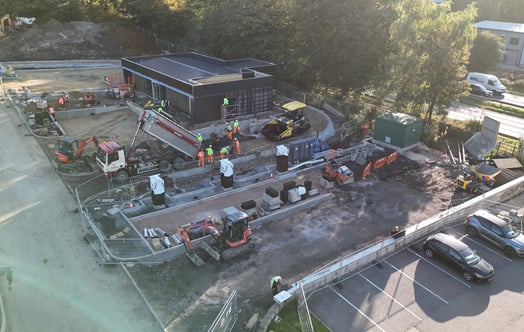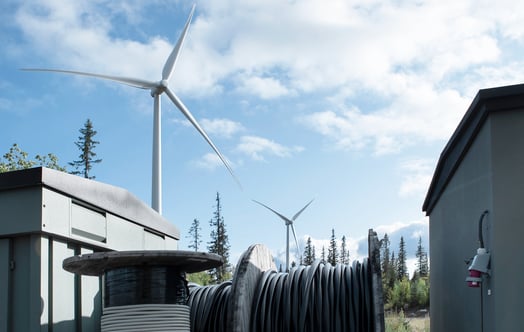
Understanding Asset Adoption Values
As an Ofgem-regulated Independent Network Operator, Vattenfall can ‘adopt’ electrical network connections and provide attractive ‘Asset Adoption Value’ payments to developers and business owners, reducing the capital cost of designing and building new power networks.
To promote competition in the connections market, Ofgem allows Independent Network Operators to use future network revenues to help subsidise the initial costs of new projects. This is referred to as the ‘Asset Adoption Value’ payment (AAV). Distribution Network Operators (DNOs) are not permitted to offer this type of payment to discount capital expenditure, it is entirely unique to IDNOs.
Vattenfall IDNO works in partnership with Independent Connection Providers (ICPs), who operate under the National Electricity Registration Scheme (NERS), to execute work on electricity networks on behalf of their clients. AAVs can be paid to the ICP, or directly to the end customer – the developer or business owner.
Where do AAV funds derive from?
The revenues that the AAV is drawn from are generated by the Distribution Use of System (DUoS) charges, which are paid by the end user of the connection, either through their energy bill or as an annual payment.
What are the benefits of Vattenfall IDNO Asset Adoption Values?
IDNO asset value payment – When Vattenfall IDNO adopts a new or upgraded network, we offer our customers an asset adoption value payment, helping to significantly reduce the total capital cost of designing and building the electrical network (see more details and the definitions of contestable works and non-contestable works). Vattenfall IDNO provides strong commercial offers, which help reduce risks for clients, and provide greater flexibility and support than working with DNOs.
Commercially advantageous – IDNO asset value contributions are not insignificant, and can amount to several hundred thousand pounds depending on the technical scope, number of connections, and the metering type associated with the new network. In some cases, an AAV can pay for a new grid connection itself.
Reserved capacity – If a developer who is looking for a new connection goes via a DNO, they will be required to pay for the total capacity from day one, which often doesn’t align with the developments build out plan. If the developer does not use the full capacity within a given timeframe, the DNO can also reclaim that capacity from them. Vattenfall IDNO, on the other hand, can sign a bilateral connection agreement with the DNO to reserve capacity on behalf of its client, so long as it can prove the project is viable and going to grow over the years.
Future-focus – Not only does Vattenfall’s IDNO not charge clients for reserving capacity, but we also ringfence the capacity of the project; offering our clients guaranteed and long-term energy security over the course of their network’s development, and total peace of mind.
Solar empowered – Vattenfall is one of the only IDNOs that are actively working with solar developers, helping to bring more renewable energy into the electricity grid. We offer strong AAVs to the solar sector, contributing to the costs of these network upgrades by investing our own funds to lay new cables and build new substations and supporting the overall transition to net zero.
How is an Asset Adoption Value calculated?
Asset Adoption Values are determined on a case-by-case basis, depending on several factors, such as which charging methodology is used; the capacity of the site; the use cases for the load, and assets to be adopted. The IDNO asset value payment itself is calculated via two main routes, depending on the project and the size of the connection that is being taken on.
- CDCM – If a project is at a lower voltage (just before 11KV) then the ‘Common Distribution Charging Methodology’ (CDCM) is applied. The rate for this is set by what the local DNO charges, and IDNOs will never charge above this. Once an IDNO, like Vattenfall, has determined these charges, we will calculate how much revenue could be made annually from that connection, and how much of that future revenue could be given back to the developer.
- EDCM – If a developer requires a higher voltage grid connection for their project, the ‘Extra High Voltage Distribution Charging Methodology’ (EDCM) is used. Via this route, Vattenfall assesses the client’s specific requirements and the value of the equipment that will be needed. Once we have deduced that value, we monetise it over a time frame to calculate how much revenue can be offered back to the client.
Unlike the CDCM – which is usage-based, the EDCM depends on the actual value of the assets. Both the CDCM and EDCM methods are fully approved by Ofgem
If you would like more details about Vattenfall IDNO Asset Value payments, or to obtain an AAV quotation for your project please contact us providing as much detail as possible. Please note Vattenfall IDNO only works on large commercial grid connections – Asset Adoption Values do not apply to domestic grid connections.



